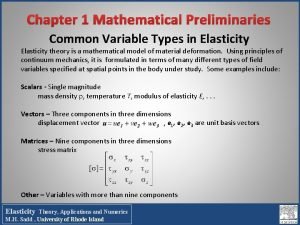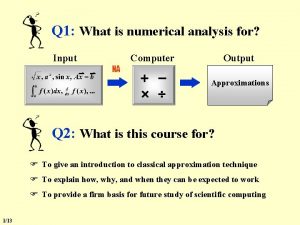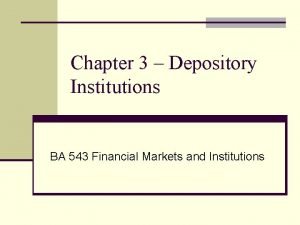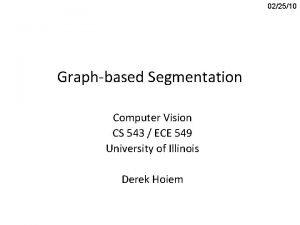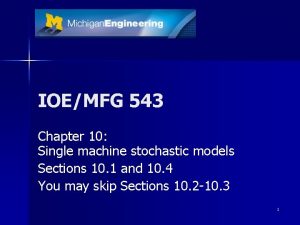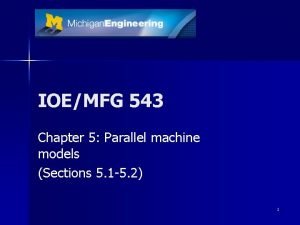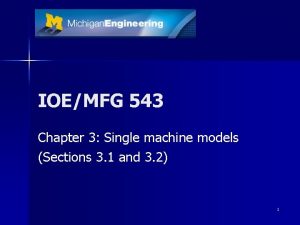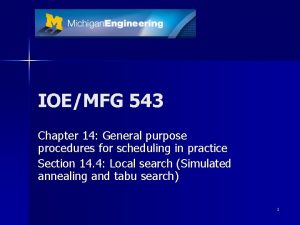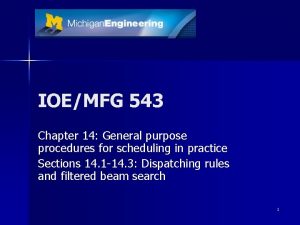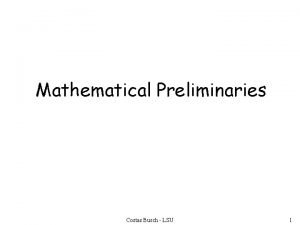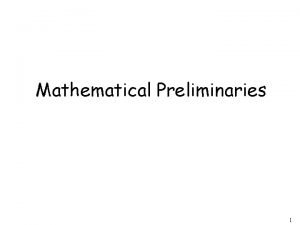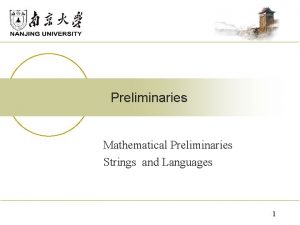IOEMFG 543 Chapter 9 Stochastic Models Preliminaries 1


















- Slides: 18

IOE/MFG 543 Chapter 9: Stochastic Models - Preliminaries 1

Uncertainty In practice, processing times, release dates, etc. , are not known exactly n Uncertainty can be caused by n – weather – machine breakdown – operator skills – unknown demand, order size –… 2

Incorporating uncertainty into scheduling models n n n Model processing times, release dates, etc. , as random variables Notation Xij = Rj Dj = = random processing time of job j on machine i random release date of job j random due date of job j Lower case letters denote realized values e. g. , xij is the actual processing time of job j on machine i and is only known after it has been processed n 1/lij = expected value of Xij 3

Probability review We only need to consider nonnegative random variables n Continuous nonnegative random variable X n – Density function f(t) t – Distribution function F(t)=P(X≤t)=∫ 0 f(s)ds n F(0)=0 and limt ∞F(t)=1 – Also define F(t)=1 -F(t)=P(X>t) Note: There is a typo in Figure 9. 1. The y-axis on the second graph should be F(t) 4

Probability review (2) n Discrete random variable X – Mass function p(t)=P(X=t) n Moments – X continuous: – – ∞ r E(X )= ∫ 0 s f(s) ds ∞ r E(X )=Ss=0 sr p(s) r X discrete: The mean E(X) is the first moment The variance is Var(X)=E(X 2)-(E(X))2 Coefficient of variation Cv(X)=(√Var(X))/E(X) 5

Completion rate n The completion rate of a job at time t – X continuous: – X discrete: n c(t)=f(t) / F(t) c(t)=p(t) / P(X≥t) Exponential random variable (continuous) – f(t)=le-lt and F(t)=1 -e-lt => c(t)=l n Geometric random variable (discrete) – p(t)=(1 -q)qt and P(X≥t)=qt => c(t)=1 -q 6

Classifying processing times according to c(t) n We can classify the random variable X as having – increasing completion rate (ICR) n c(t) is increasing in t – decreasing completion rate (DCR) n n n c(t) is decreasing in t The exponential and geometric have a constant c(t) so are both ICR and DCR Some random variables are neither ICR nor DCR 7

Comparing random variables How can we compare two random processing times X 1 and X 2? n Perhaps base the first order of comparison on the mean n If the means are equal then look at the variance n 8

Stochastic dominance based on expectation X 1 is larger in expectation than X 2 if E(X 1)≥E(X 2) ii. X 1 is stochastically larger in than X 2 if P(X 1>t)≥P(X 2>t) and is denoted by X 1≥st X 2 i. 9

Stochastic dominance based on expectation (2) iii. X 1 is larger in the likelihood ratio sense than X 2 if the likelihood ratio X 1 and X 2 continuous: f 1(t)/f 2(t) X 1 and X 2 discrete: p 1(t)/p 2(t) is nondecreasing This is denoted by X 1≥lr X 2 iv. X 1 is almost surely larger than X 2 if P(X 1≥ X 2)=1 and is denoted by X 1≥as X 2 n Note that iv iii i 10

Stochastic dominance based on variance i. ii. X 1 is larger in the variance sense than X 2 if Var(X 1)≥Var(X 2) X 1 is more variable than X 2 if X 1 and X 2 continuous: ∞ ∞ ∫ 0 h(t) d. F 1(t) ≥ ∫ 0 h(t) d. F 2(t) X 1 and X 2 discrete: ∞ S∞ h(t ) p (t) ≥ S t=0 1 t=0 h(t) p 2(t) for all convex functions h(t) This is denoted by X 1≥cx X 2 11

Stochastic dominance based on variance (2) iii. X 1 is symmetrically more variable than X 2 if f 1(t) and f 2(t) are symmetric about the same mean 1/l and F 1(t)≥F 2(t) for t ≤ 1/l and F 1(t)≤F 2(t) for t ≥ 1/l 1. The above variability orderings are based on the assumption that E(X 1)=E(X 2) 2. Note that iii i 12

Increasing convex ordering 1. Continuous case 1. X 1 is larger than X 2 in the increasing convex sense if ∞ ∞ ∫ 0 h(t) d. F 1(t) ≥ ∫ 0 h(t) d. F 2(t) for all increasing convex functions h(t) 2. Discrete case 1. X 1 is larger than X 2 in the increasing convex sense if ∞ h(t) p (t) ≥ S ∞ h(t) p (t) St=0 1 t=0 2 for all increasing convex functions h(t) 3. This is denoted by X 1≥icx X 2 13

Lemma 9. 4. 2 n Let Z(1)=g(X 1(1), X 2(1), …, Xn(1)) and Z(2)=g(X 1(2), X 2(2), …, Xn(2)) where g is increasing convex in each argument n n n If X 1(j)≥icx X 2(j) for all j then Z(1)≥icx. Z(2) Example 9. 4. 3 Example 9. 4. 4 14

Lemma 9. 4. 5 n If F 1 is deterministic, F 2 is ICR, F 3 is exponential and F 4 is DCR then F 1 ≤cx F 2 ≤cx F 3≤cx F 4 n We can use this result to get bounds on performance measures – Example 9. 4. 6 15

Classes of policies When scheduling under uncertainty new information becomes available as the jobs are processed, e. g. , the processing times of the completed jobs are known n Instead of a fixed schedule it may be better to develop a policy which prescribes what job to schedule next n 16

Static list policies n Nonpreemptive static list policy n Preemptive static list policy – The decision maker orders the jobs at time zero according to a priority list. This priority list does not change during the evolution of the process, and every time a machine is freed the next job on the list selected for processing – The decision maker orders the jobs at time zero according to a priority list. This list includes jobs with nonzero release dates. This list does not change during the evolution of the process, and at any point in time the job at the top of the list of available jobs is selected for processing 17

Dynamic policies n Nonpreemptive dynamic policy n Preemptive dynamic policy – Whenever a machine is freed the decision maker chooses which job goes next. The decision may depend on all the information available at that time (e. g. , jobs waiting for processing, jobs being processed on other machines and the amount of processing they have had) – At any point in time the decision maker chooses which job should be processed on the machine. The decision may depend on all the information available at that time and may require preemptions 18
 Chapter 1 mathematical preliminaries
Chapter 1 mathematical preliminaries Deterministic demand vs stochastic demand
Deterministic demand vs stochastic demand Deterministic and stochastic inventory models
Deterministic and stochastic inventory models Apa itu preliminaries
Apa itu preliminaries Preliminary material
Preliminary material Halaman preliminaries
Halaman preliminaries Mathematical preliminaries in numerical computing
Mathematical preliminaries in numerical computing Dark synoynm
Dark synoynm Unit 543 research project examples
Unit 543 research project examples Ece 543
Ece 543 Ocr scanner
Ocr scanner 543 machine
543 machine Ba543
Ba543 Ba 543
Ba 543 Ba 543
Ba 543 Cs 543
Cs 543 Cs 543
Cs 543 Difference between models and semi modals
Difference between models and semi modals Stochastic rounding
Stochastic rounding
